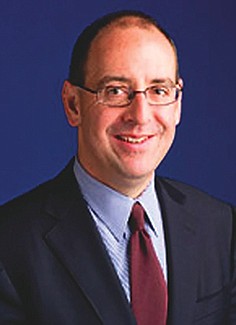 Facebook
Facebook
 X
X
 Instagram
Instagram
 TikTok
TikTok
 Youtube
Youtube

In early September of 2016, the shocking news broke: thousands of employees of Wells Fargo Bank — generally considered a relatively pure institution — had secretly opened millions of unauthorized deposit and credit card accounts that customers knew nothing about.
The phony accounts had been created because management put so much pressure on employees to jack up revenues.
Wells was fined $185 million by regulatory bodies and the City of Los Angeles, fired more than 5000 employees, and dumped its chief executive. But one finger in the dike was not going to be sufficient.
At the time of the revelations, Wells stock was around $50. It drifted down to the mid-$40s, then, the day after the November election, began shooting up to $55 as Wall Street exulted that the new president, Donald Trump, will tear down regulations and generally be easy on banks and businesses.

A San Diegan had dared to warn the public about Wells Fargo back in January of 2013. Frank Partnoy, law professor at the University of San Diego, along with Jesse Eisinger, financial reporter for ProPublica, wrote an article on the subject for the Atlantic magazine. The gist was that big banks’ financial reporting was so obfuscated that even the most sophisticated investors couldn’t figure out what a bank was worth.

As an example of a bank hiding its financial risks, Partnoy and Eisinger stunned Wall Street by selecting the supposedly chaste Wells Fargo. Explained the article, “Wells Fargo was founded on trust. Its logo has long been a strongly sprung six-horse stagecoach” that used to carry gold through dangerous Western territory. Multibillionaire investor Warren Buffett was so impressed that his firm, Berkshire Hathaway, owns about 10 percent of the stock, and Buffett is said to have $100 million worth of it in his personal account.
The article warned of the consequences of inscrutable banks. “As trust diminishes, the likelihood of another crisis grows larger,” wrote the authors. “The next big storm might blow the weakened house down.”
The authors combed through the annual financial statement of Wells Fargo. “The bank is not what it seems,” they said. Financial details “range from the incomprehensible to the disturbing.” The bank’s so-called disclosures “are littered with language that says nothing, at length. The report is riddled with progressively more opaque footnotes — the financial equivalent of Dante’s descent into hell.”
Partnoy and Eisinger asked the bank if they could talk to Wells Fargo officials about this opacity. They got this response from a public relations executive: “We believe our disclosures on the topics you raised are comprehensive and stand on their own.”
Wrote Partnoy and Eisinger, “In answering our written questions about the annual report, the representatives simply pointed us back to the annual report.”
Partnoy and Eisinger wanted to know the fair value of securities held by the bank. Wells Fargo broke those securities into three categories. The third category was “hair-raising,” they wrote. The bank in its annual report said that the third level estimates are “generated primarily from model-based techniques that use significant assumptions not observable in the market.”
Huh? “Not observable in the market”?
Accountants and regulators can’t pierce these hazy statements. Who oversees the estimates? “Auditors who are dependent on the bank for significant revenue, and regulators who are endemically behind the curve,” answered Partnoy and Eisinger.
So now we know that Wells Fargo employees falsified millions of accounts. In short order, we have learned that Wells was also selling Prudential life insurance policies to people without their permission — allegedly exploiting those who didn’t speak English. Prudential stopped selling the policies through Wells Fargo. Then came the waterfall: ex-Wells managers sued, saying the blame for the fakery belonged well up the managerial chain. California state treasurer John Chiang severed many of the state’s ties with the bank as the California Department of Insurance launched an investigation. Seattle dropped the bank as a lender, and the Better Business Bureau yanked the bank’s accreditation.
I asked Partnoy about the bank’s woes. “When you get an annual report from a company and can’t understand it, that should trigger a lot of questions about what’s happening at the company. If its practice is to hide and obfuscate, it’s not surprising there were hidden troubles.”
It may be a case of “dry rot,” says Partnoy. “When you have opacity [in the annual report], you can get rot within another portion of a company. It’s like a house. You can’t look within the walls. You may have mold or radon or rot. It doesn’t mean someone wouldn’t pay a lot of money for the house. It may be standing for decades, but you should be worried about what is happening inside the walls. It may be a few pesky mice and termites, or there may be millions of pests eating away at the foundation. The problem I have with banks is that you can’t tell from looking at them.” Is there a “small termite problem” or should the public suspect “something foundational”?
That is, should you and I feel secure if we don’t bank at Wells Fargo? Absolutely not.
“In general, banks move in packs. It would be surprising if Wells Fargo were a lone wolf,” says Partnoy.
“Banks are still a mystery, a black box. They are such an important part of our economy. You would think there would be pressure to look inside banks [more thoroughly]. But markets don’t seem to care because banks [appear] profitable.”
There have been warnings, though. On December 15, Tom Flannigan of Seeking Alpha wrote, “Wells Fargo faces continued regulatory risks and has a tarnished image. Rebuilding the Wells Fargo brand will be difficult and time-consuming.” The legendary bank’s “wheels are falling off the stagecoach.”


In early September of 2016, the shocking news broke: thousands of employees of Wells Fargo Bank — generally considered a relatively pure institution — had secretly opened millions of unauthorized deposit and credit card accounts that customers knew nothing about.
The phony accounts had been created because management put so much pressure on employees to jack up revenues.
Wells was fined $185 million by regulatory bodies and the City of Los Angeles, fired more than 5000 employees, and dumped its chief executive. But one finger in the dike was not going to be sufficient.
At the time of the revelations, Wells stock was around $50. It drifted down to the mid-$40s, then, the day after the November election, began shooting up to $55 as Wall Street exulted that the new president, Donald Trump, will tear down regulations and generally be easy on banks and businesses.

A San Diegan had dared to warn the public about Wells Fargo back in January of 2013. Frank Partnoy, law professor at the University of San Diego, along with Jesse Eisinger, financial reporter for ProPublica, wrote an article on the subject for the Atlantic magazine. The gist was that big banks’ financial reporting was so obfuscated that even the most sophisticated investors couldn’t figure out what a bank was worth.

As an example of a bank hiding its financial risks, Partnoy and Eisinger stunned Wall Street by selecting the supposedly chaste Wells Fargo. Explained the article, “Wells Fargo was founded on trust. Its logo has long been a strongly sprung six-horse stagecoach” that used to carry gold through dangerous Western territory. Multibillionaire investor Warren Buffett was so impressed that his firm, Berkshire Hathaway, owns about 10 percent of the stock, and Buffett is said to have $100 million worth of it in his personal account.
The article warned of the consequences of inscrutable banks. “As trust diminishes, the likelihood of another crisis grows larger,” wrote the authors. “The next big storm might blow the weakened house down.”
The authors combed through the annual financial statement of Wells Fargo. “The bank is not what it seems,” they said. Financial details “range from the incomprehensible to the disturbing.” The bank’s so-called disclosures “are littered with language that says nothing, at length. The report is riddled with progressively more opaque footnotes — the financial equivalent of Dante’s descent into hell.”
Partnoy and Eisinger asked the bank if they could talk to Wells Fargo officials about this opacity. They got this response from a public relations executive: “We believe our disclosures on the topics you raised are comprehensive and stand on their own.”
Wrote Partnoy and Eisinger, “In answering our written questions about the annual report, the representatives simply pointed us back to the annual report.”
Partnoy and Eisinger wanted to know the fair value of securities held by the bank. Wells Fargo broke those securities into three categories. The third category was “hair-raising,” they wrote. The bank in its annual report said that the third level estimates are “generated primarily from model-based techniques that use significant assumptions not observable in the market.”
Huh? “Not observable in the market”?
Accountants and regulators can’t pierce these hazy statements. Who oversees the estimates? “Auditors who are dependent on the bank for significant revenue, and regulators who are endemically behind the curve,” answered Partnoy and Eisinger.
So now we know that Wells Fargo employees falsified millions of accounts. In short order, we have learned that Wells was also selling Prudential life insurance policies to people without their permission — allegedly exploiting those who didn’t speak English. Prudential stopped selling the policies through Wells Fargo. Then came the waterfall: ex-Wells managers sued, saying the blame for the fakery belonged well up the managerial chain. California state treasurer John Chiang severed many of the state’s ties with the bank as the California Department of Insurance launched an investigation. Seattle dropped the bank as a lender, and the Better Business Bureau yanked the bank’s accreditation.
I asked Partnoy about the bank’s woes. “When you get an annual report from a company and can’t understand it, that should trigger a lot of questions about what’s happening at the company. If its practice is to hide and obfuscate, it’s not surprising there were hidden troubles.”
It may be a case of “dry rot,” says Partnoy. “When you have opacity [in the annual report], you can get rot within another portion of a company. It’s like a house. You can’t look within the walls. You may have mold or radon or rot. It doesn’t mean someone wouldn’t pay a lot of money for the house. It may be standing for decades, but you should be worried about what is happening inside the walls. It may be a few pesky mice and termites, or there may be millions of pests eating away at the foundation. The problem I have with banks is that you can’t tell from looking at them.” Is there a “small termite problem” or should the public suspect “something foundational”?
That is, should you and I feel secure if we don’t bank at Wells Fargo? Absolutely not.
“In general, banks move in packs. It would be surprising if Wells Fargo were a lone wolf,” says Partnoy.
“Banks are still a mystery, a black box. They are such an important part of our economy. You would think there would be pressure to look inside banks [more thoroughly]. But markets don’t seem to care because banks [appear] profitable.”
There have been warnings, though. On December 15, Tom Flannigan of Seeking Alpha wrote, “Wells Fargo faces continued regulatory risks and has a tarnished image. Rebuilding the Wells Fargo brand will be difficult and time-consuming.” The legendary bank’s “wheels are falling off the stagecoach.”
Comments